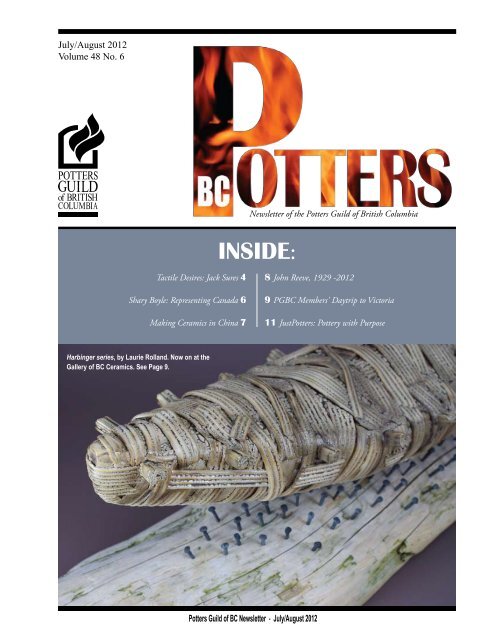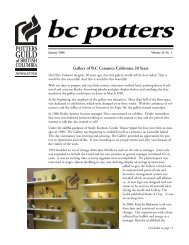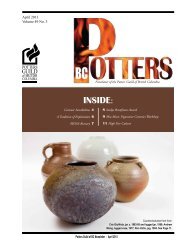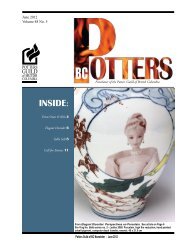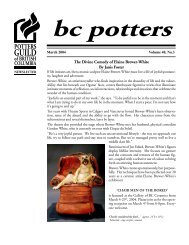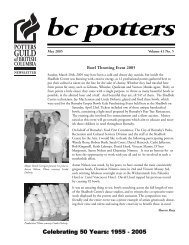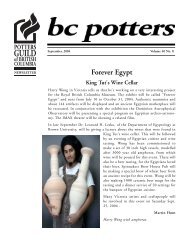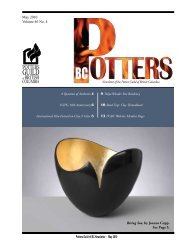Create successful ePaper yourself
Turn your PDF publications into a flip-book with our unique Google optimized e-Paper software.
Tactile Desires: The Work <strong>of</strong> Jack Sures By Amy GogartyHand Built Pot, 1968; oxides, fibreglassstoneware, 59.5 x 60 x 60 cm. SaskatchewanArts Board Permanent Collection.The Answer, 1987; sprayed engobe,stoneware tiles, 235 x 197 x 5.7. Collection <strong>of</strong>Jack Sures and Cara Gay Driscoll.Catalogue <strong>of</strong> the exhibition at the MacKenzieArt Gallery, Regina, Sask., 24 September2011 – 2 January, 2012, travelling to OwenSound and beyond. Available from theMacKenzie for $44.95 plus tax and shippingfrom galleryshop@mackenzieartgallery.ca or306.584.4270.The work <strong>of</strong> Regina clay artist Jack Suresis not as well-known as it should be here onthe west coast, but in Regina, Sures is a majorfigure whose influence extends through histeaching, public commissions, elegant ceramicvessels and graphic works. The MacKenziehas assembled an impressive selection <strong>of</strong>107 vessels, platters, decorated tiles andgraphic works dating from 1964 through to2010, accompanying this with a beautifullyillustrated catalogue with essays by curatorVirginia Eichhorn, associate curators JuliaKrueger and Timothy Long, craft historianSandra Alfoldy and Seattle art critic MatthewKangas. For those unfamiliar with Sures, thecatalogue provides an excellent introductionto his work, and for those interested incontemporary ceramic criticism, history andtheory, it <strong>of</strong>fers much to consider.Born to Russian Jewish immigrants in 1934,Sures was raised partly by his grandparents inWinnipeg, where he was first exposed to artsand crafts classes. After entering universityto study science, he switched to fine arts,supporting himself in school by workingon the railway. He travelled extensively,working his way across Britain, Europe, theMiddle East and Israel. In 1972, he travelledto Grenada with the United Nations andset up a ceramics program that is still inoperation. For thirty-two years he taught atthe University <strong>of</strong> Regina, where he mentoredseveral generations <strong>of</strong> ceramists. Sures was akey factor in the Regina Clay movement anddid much to maintain a dialogue betweenRegina and California. He is known for hislarge thrown and textured vessels, many<strong>of</strong> which feature animal imagery as surfacedecoration or ornamental additions, and forhis architectural murals that appear on publicbuildings such as the Canadian Museum <strong>of</strong>Civilization across Canada.Tactile Desires is a model <strong>of</strong> clarity with itsorderly presentation <strong>of</strong> a detailed chronology,bibliography and handsome photography.The list <strong>of</strong> works provides comprehensiveinformation on medium, size, collection andpage on which the work is reproduced. Onemight think this is stating the obvious, but,unfortunately, all too many publications missthe opportunity to organize and present thisinformation in a practical manner. This alonewould establish the value <strong>of</strong> this catalogue,yet, thankfully, there are also five essays toenlighten and challenge the reader.Curator Virginia Eichhorn outlines theprimary events and influences in Sures’life and work, exploring issues such as theeroticism and sensuality in his work. She seesthese as factors reflecting changing sexualmores in Canada, the artist’s three marriagesand his remarkable physical energy. Eichhorncalls Sures “an unrepentant sensualist” andhis work “the physical manifestation <strong>of</strong> histactile desires” (27). Seattle critic MatthewKangas places Sures’ work in an internationalcontext, stressing the emergence post-WWII<strong>of</strong> a “global ethic <strong>of</strong> the handmade...hybridblends <strong>of</strong> the internationally informed craftobject” (43). Travel and extended stays inGreat Britain, France, Japan and the UnitedStates introduced Sures to an internationalcommunity <strong>of</strong> artists and world art traditions.Living in Regina, he encountered thefamous Emma Lake Artists’ Workshops andAmerican legends Clement Greenberg andJohn Cage. As the ceramic program expandedin Regina, it attracted students and pr<strong>of</strong>essorsfrom across North America, notably thehyper-realist ceramic sculptor MarilynLevine and the California Funk artist DavidGilhooly. As Kangas details, these influencescreated an extremely fertile and sophisticatedenvironment in Regina, encouraging thecreation <strong>of</strong> work that was outward-lookingand world-class in stature.Timothy Long focuses on Sures’ large-scalepublic murals. Exploring the art/craft debatewith fresh insight and relating anecdotesdrawn from his experience as a curator, Longtells a story in which he puzzled over theorientation <strong>of</strong> what he called an “ugly” potfrom the late 1960s. Years later, he discoveredthe so-called sculpture was actually a hangingplanter missing its rope. He uses this anecdoteto explore the variety <strong>of</strong> “frames” that havebeen applied to Sures’ work over the yearsand to question issues <strong>of</strong> boundaries betweenart and craft. Long argues that the “framingdevices” developed to discuss artworksContinued on Page 5, Jack Sures<strong>Potters</strong> <strong>Guild</strong> <strong>of</strong> <strong>BC</strong> Newsletter . July/August 20124
Jack Sures,Cont'd from Page 4do not necessarily apply to craft objects,which come from a very different historicaltradition. By transgressing perimeters, leavingedges unfinished and collapsing differencesbetween image and object, Sures’ sculpturalmurals negotiate their position within the artworld on their own terms. Long concludes,“Rather than turn murals into another type<strong>of</strong> painting, or vessels into another form <strong>of</strong>sculpture, Sures shows that it is ultimatelymore radical and more productive for theceramic art object to retain the frame <strong>of</strong> craft”(69). Amen to that!Julia Krueger contributes a playful yettheoretically-sophisticated essay that exploresSures’ use <strong>of</strong> animal imagery. She introducesCharles Darwin, who warned againstconclusions about natural selection basedsolely on the existing geological record—afterall, much <strong>of</strong> the earth is inaccessible, andnot all creatures left fossilized traces. Just so,one cannot trace a linear path through Sures’use and development <strong>of</strong> animal imagery,which culminates in a creature known as a“Bandicoot,” after the Australian marsupialthat Sures’ unique quadruped resembled.Untitled, 1987; underglaze pencil, black glaze, porcelain, 12 x 49 x 49 cm. Collection <strong>of</strong> theMoose Jaw Museum Art Gallery.Krueger introduces core craft concepts such asworkmanship and the presence <strong>of</strong> the hand tocritique Sures’ work, echoing Long’s assertionthat concepts developed in art history cannotfully account for the diversity and materiality<strong>of</strong> craft. She includes several small drawingsin her essay to demonstrate the artist’smovements between graphic and ceramicexpression, emphasizing the use <strong>of</strong> the doodlein his vibrant surface design. Exploring howSures gouged and worked his surfaces muchas an animal might, she concurs with GlennAdamson that “craft is not a classification <strong>of</strong>objects but . . . a way <strong>of</strong> doing things” (83).The final essay by craft historian SandraAlfoldy examines Sures as a precursor to thecontemporary DIY, paradisciplinary or postmodernmaker, arguing that the generationaldivide <strong>of</strong>ten posited between older, establishedmakers and emerging artists obscuresimportant commonalities. Alfoldy describesSures as an “alpha maker,” one who “designsand builds cool stuff” (93). Throughout hiscareer, Sures was innovative, experimentaland charismatic; he challenged disciplinaryboundaries and infused his work with a sort<strong>of</strong> playful irony that resonates with todays“hipster” DIY makers.With its beautiful photographs, solidhistorical research and provocative essays,this catalogue is a treat to read, a welcomeintroduction to an artist who should be betterknown and a model <strong>of</strong> scholarship to inspireothers documenting Canada’s craft history.CreteMoroccoBurmaOct. 8-23, 2012 Nov. 5-26, 2012 January 2013<strong>Potters</strong> <strong>Guild</strong> <strong>of</strong> <strong>BC</strong> Newsletter . July/August 20125
Shary Boyle to represent Canadaat Venice BiennaleShary Boyle, a Toronto artist whose quirky pieces <strong>of</strong>ten involvea dark, feminist twist, has been selected to represent Canada at theVenice Biennale art exhibition in 2013.Marc Mayer, director <strong>of</strong> the National Gallery <strong>of</strong> Canada, made theannouncement late Friday in Toronto. The Ottawa-based NGC isworking with the Canada Council for the Arts to organize Canada'sexhibit, which will be curated by the NGC’s Josée Drouin-Brisebois.Prior to 2010, curators from across the country were invited to applyon behalf <strong>of</strong> artists. However, during the past two years, the NGCchose a committee <strong>of</strong> contemporary curators to select the artist whowould represent Canada.Brisebois praised Boyle's art for its “personal vision <strong>of</strong> sexuality,relationships and human vulnerability.”As an <strong>of</strong>ficial entry at the Venice Biennale, Boyle will draw theattention <strong>of</strong> the international art world, but she’ll also have to raisemoney to pay for her exhibit. The Department <strong>of</strong> Foreign Affairs cutits funding for the prestigious art fair in 2009. According to the NGC,private philanthropists will contribute to the show.Boyle is known for her hand-painted porcelain figurines, <strong>of</strong>tenamusing depictions that put a new spin on a mythical story. She hasworked in a variety <strong>of</strong> media, including animated projections that haveaccompanied concerts by musicians and singers such as Feist, Peaches,Doug Paisley and Christine Fellows.She has been a darling <strong>of</strong> the Canadian contemporary art worldduring the last few years. She earned a nomination for the Sobey ArtThe Rejection <strong>of</strong> Pluto, a 2008 porcelain sculpture by artist SharyBoyle, is part <strong>of</strong> the permanent collection <strong>of</strong> the Art Gallery <strong>of</strong>Ontario. (Art Gallery <strong>of</strong> Ontario)Award and won both the Gershon Iskowitz Prize in 2009 and theHnatyshyn Foundation Award in 2010.Born in Scarborough, Ont., in 1972, Boyle graduated from theOntario College <strong>of</strong> Art and Design in Toronto in 1994. She has hadsolo exhibitions in Canada, the United States and Europe.Boyle has a year to put together a new show for the CanadianPavilion in Venice.Artists who have represented Canada at the Biennale in recent yearsinclude Steven Shearer and David Altmejd.This article was comes from the cbc.ca Arts &Entertainment section here: http://www.cbc.ca/news/arts/story/2012/06/25/sharyboyle-venice.htmlCheck this out!C<strong>BC</strong> Interview withDenise JeffreyDenise Jeffrey was interviewed by theC<strong>BC</strong>`s Sheryl MacKay on North ByNorthwest. Listen to the podcast here:http://podcast.cbc.ca/mp3/podcasts/bcnxnw_20120722_23474.mp3<strong>Potters</strong> <strong>Guild</strong> <strong>of</strong> <strong>BC</strong> Newsletter . July/August 20126
Making Ceramics in China By Suzu MatsudaThis past May my husband Larry Cohen and I participated in aresidency program at the Art Institute <strong>of</strong> Sanbao in China about 10kilometers from the city <strong>of</strong> Jingdezhen. The city <strong>of</strong> 1.6 million hasbeen known as the “porcelain city” since the Song Dynasty and hasa history <strong>of</strong> porcelain making that spans 1000 years. Large porcelainvases and ceramic ware <strong>of</strong> many sizes and shapes line some streets <strong>of</strong>the city, and the poles <strong>of</strong> street lamps and stop signs are covered withpainted ceramic.The road to Sanbao takes us into the country: lush with greenery,flanked by mountains on both sides and a river running along the side<strong>of</strong> the road. The Art Institute is a complex <strong>of</strong> buildings that look likethe China <strong>of</strong> the past. The main building has rooms for residents, arestaurant, a gift shop, a bar and an administration <strong>of</strong>fice. Antiquesand ceramics are a part <strong>of</strong> the environment; pottery shards areincorporated in walk ways and walls, and posters <strong>of</strong> ceramic exhibitsare on the walls. Many come to visit this site for a delicious meal and alook around; everyday there were guests taking pictures and enjoyingthe ambiance. The building is beautiful. Our room was light and airy,and we would wake up to the sound <strong>of</strong> geese and chickens below usand the sight <strong>of</strong> mist on the mountains.Master Ceramist Jackson Li in collaboration <strong>of</strong> his sister Wenying(Wendi) Li envisioned a residency program for artists from all over theworld. They come to make art and ceramics and sometimes work withstudents and artists <strong>of</strong> China. When we arrived, there was a group <strong>of</strong>students and their teacher from Lakehead University in Thunder Bay,Ontario. They were making ceramic sculpture. They also had a smallexhibition with some Chinese students <strong>of</strong> ceramics. Shortly after theyleft, a group <strong>of</strong> master ceramic artists from Delft, the Netherlands,arrived. They made their own work and worked along-side ceramicartists from other parts <strong>of</strong> China later in their stay. They were to havean exhibition in Shanghai in the fall <strong>of</strong> 2012 and later show the workin Delft.Larry and I worked in large studio space a short walk from the mainbuilding. I worked on a second floor throwing ware with one <strong>of</strong> themany Shimpo wheels using the area’s famous porcelain clay. Larryhand-built pieces on the third floor in a beautiful spacious studio. Wehad our work bisqued, spray glazed, and fired in a propane-fired kiln byspecialists, who loaded the kilns, glazed our pots, and fired the kiln.Across from our studios was the workshop <strong>of</strong> Jackson Li, a beautifulwooden building with a river flowing past. At the time we were there,Jackson was producing artisanal-style stoneware, tablets <strong>of</strong> clay withrelief to be fired with a celadon glaze, and very large platters withcopper red under glaze paintings. He had many people working withhim: Mashifu, who threw his ware and fired his kilns; an over glazepainter who painted detailed intricate designs on bisque ware; Xiao,who glazed pots and loaded kilns, and a person who was makingbrushes out <strong>of</strong> bamboo. On the ground level <strong>of</strong> our studio space therewere three gas-fired kilns, several electric kilns and a wood-fired kiln.There was always lots <strong>of</strong> activity in the studio area, and I enjoyedwatching how things were done.The city <strong>of</strong> Jingdezhen has many resources related to ceramics. Thereis a glaze street with many shops selling pre-mixed glazes <strong>of</strong> everycolour, and there are stores that sell tools for making ceramics, andbrushes and supplies for painting on ceramics. We visited a sculpturefactory with studios for those making ceramics, and endless marketsCeramic stop light in Jingdezhen. Photo by Suzu Matsuda.and small shops where ceramics were sold—some very beautiful, andsome very ordinary. There is a district where clay tiles <strong>of</strong> almost everysize were made for painting. We watched them make perfect 2’ x 4’tiles, which they painted with traditional blue under-glaze, coveredwith a clear glaze and loaded into the kiln. Public kilns were availablefor a per-square-inch price. Jingdezhen is to ceramics as Detroit was tothe automobile. Evidence <strong>of</strong> ceramics was everywhere we went. It wasan exciting, inspiring, and unforgettable experience.Suzu Matsuda and Larry Cohen have been involved with ceramicssince the 1970s.Jackson Li’s Studio. Photo by Suzu Matsuda.<strong>Potters</strong> <strong>Guild</strong> <strong>of</strong> <strong>BC</strong> Newsletter . July/August 20127
JOHN REEVE, 1929 - 2012By Nora VaillantJohn Reeve at Tam Irving's studio, Fisherman's Cove, WestVancouver, B.C., late 1970s. Courtesy <strong>of</strong> Ron Vallis.Photo: Sally MichenerWith sadness we mark the passing <strong>of</strong> John Reeve, potter, teacher andfriend to many <strong>of</strong> us in his former home <strong>of</strong> British Columbia. Johndied in Abiquiu, New Mexico on June 28 after a prolonged illness. Hewas born in Barrie, Ont. in 1929 and attended the Vancouver School<strong>of</strong> Art from 1953 to 1955. John traveled to England in 1957 wherehe studied with Colin Pearson and Harry Davis before becoming anapprentice at the Leach Pottery in 1958. Upon his return to Vancouverin 1961, John taught many aspiring potters through the U<strong>BC</strong> ExtensionDepartment and the Vancouver School <strong>of</strong> Art. His 1972 exhibition atthe Vancouver Art Gallery curated by Doris Shadbolt made a lastingimpression on viewers. From 1977 to 1979, John served as the head <strong>of</strong>the ceramics program at Nova Scotia College <strong>of</strong> Art and Design.John taught and worked across three countries over the course <strong>of</strong>his long life. In England, he established Longlands Pottery, taught atFarnham School <strong>of</strong> Art and returned for a time to the Leach Pottery.In the United States, he spent extended periods at the home <strong>of</strong> hisfriend and fellow Leach alumnus, Warren MacKenzie. He workedin MacKenzie’s studio and was invited to teach at the University<strong>of</strong> Minnesota on numerous occasions. He traveled extensively inCalifornia and Colorado <strong>of</strong>fering workshops and making pots. Heis known for his pioneering work in the exploration <strong>of</strong> porcelainclay bodies and his expertise in glaze technology. In the late 1980sJohn settled down in New Mexico where he became involved in thedevelopment <strong>of</strong> Santa Fe Clay Co.The 2004 exhibition, Thrown: Influences and Intentions <strong>of</strong> WestCoast Ceramics held at U<strong>BC</strong>’s Belkin Art Gallery and two additionalexhibitions <strong>of</strong> his work at the B.C. Gallery <strong>of</strong> Ceramics, brought Johnback to Vancouver for several visits in recent years during which hemade pots at Martin Peter’s Dunbar studio.John was a superb potter, a master <strong>of</strong> form and a natural teacher.He had a powerful influence on potters from many communitiesduring his eighty-three years, <strong>of</strong>ten surprising and inspiring us withhis unique perspective. One student’s memory <strong>of</strong> a comment made byJohn at a workshop captures his intuitive relationship to both clay andteaching: “Some people try to centre clay and others let the clay centrethem.” He will be missed.New Website: Canadian Studio Ceramics, 1900 to the PresentRequest for Information and AssistanceThis is to announce the development <strong>of</strong> a “one-stop” website focusedon Canadian studio pottery. Individuals, organizations and institutionsare invited to participate in providing content for the site. The site willhave the following four objectives.1. To document the development <strong>of</strong> studio ceramics fromaround 1900 to the present: artists, aesthetics, styles, schools,organizations, collectors.2. To develop a venue for creators, collectors and educators toshare information and knowledge.3. To document “who’s who” in the many branches <strong>of</strong> theCanadian ceramic world.4. To provide a more open forum for the sharing <strong>of</strong> historicalceramic information.I am interested in archival, historical, anecdotal, pictorial, andbiographical data, information and sources. For those wishing toparticipate I will be willing also to share my own research results overthe past three decades. In other words, the site could develop moreas a Commons than one individual’s storehouse. Intellectual propertyrights will <strong>of</strong> course be respected.For those interested please contact Barry Morrison at:barrymorrison9@gmail.comorhttp://ca.linkedin.com/in/barryemorrison<strong>Potters</strong> <strong>Guild</strong> <strong>of</strong> <strong>BC</strong> Newsletter . July/August 20128
Laurie Rolland: Harbinger By Amy GogartyExhibiting at the Gallery <strong>of</strong> <strong>BC</strong> CeramicsJuly 7 to Aug. 7.Since 1997, ceramic sculptor Laurie Rollandhas worked with boats as metaphorical vesselsconveying ideas, spiritual references andhealing energy. Rolland was a core member<strong>of</strong> the <strong>BC</strong> collective Fired Up! from 1994to 2004, and she has exhibited her worknationally and internationally. Her exhibitionHarbinger at the Gallery <strong>of</strong> <strong>BC</strong> Ceramicsruns from July 7 to August 7. The artist livesin Sechelt where her daily interactions withthe natural world clearly inspire her. As shedescribes it, “A deep reverence for the naturalworld, combined with an interest in ancientearth-based religions, informs this work.”Rolland attaches short explanatory textsto many <strong>of</strong> her works in the exhibition.While these provide interesting insight intothe artist’s thinking, they can also distract.For example, a series <strong>of</strong> plates entitled theContinuum Series features lines and circles,which the artist asserts represent “male andfemale...and the healing <strong>of</strong> conflict betweenthe two,” but the works can also be enjoyedfor their attractive use <strong>of</strong> geometric elementsdevoid <strong>of</strong> symbolism. In some cases, however,her preoccupations are well-supported, as withher signature Harbinger Series #2. This consists<strong>of</strong> a clay vessel wrapped in what appear to bereeds; it balances on rusty nails that protrudefrom a boat-shaped piece <strong>of</strong> driftwood. Honeycoloured in the highlights and darker wherestains have been rubbed into the texturedreeds, the work is “freighted”—heavy withsymbolic import, poetry and a sense <strong>of</strong>containment. For Rolland, the boat representsthe spirit <strong>of</strong> hope and peace floating abovethe <strong>of</strong>ten “thorny” problems <strong>of</strong> the real worldrepresented by the rusty nails and driftwood.As a harbinger, it brings the hope <strong>of</strong> healingand change to come.Other works speak to the artist’s interest inancient symbols, spirituality and the dualisms<strong>of</strong> light and dark, time and space, birth anddeath. Skeletal Vessel depicts the ribs <strong>of</strong> anabandoned boat, suggesting parallels betweenthe vessel and a once-living body. The ribsand keel are constructed from flattened claystrips lashed together much as a primitiveboat might have been, and it is stained toappear weathered and ancient. Cargo Vesselwith Rattle Seed Pod is powerful in its starksimplicity. Constructed as an open slab vessel,the surface puckered with a brown and rustglaze, the boat ferries a pod-shaped rattle,which is dark and redolent <strong>of</strong> life within. Thework effectively conveys tranquility and asense <strong>of</strong> life’s passage through time.The artist is quite inventive when formingand combining components, as is borne outin a series <strong>of</strong> Small Totems. These consist <strong>of</strong>sculptural forms that resemble crustaceanclaws or ancient stone tools. They have apleasing scale, volume and surface texture,which makes them amenable to handling andopen to a variety <strong>of</strong> playful arrangements.They seem to be maquettes or experimentsthat have received further development inIn the Garden, a work in which three alertfigures with strongly articulated and texturedbodies stand guard within a dark receptacle.For the artist, the dark colour representsfertility and the boat form a garden <strong>of</strong> earthlyparadise. One figure is topped with uprighthorns, which traditionally designate the GreatMother goddess, while the two other totemscombine eccentric and strongly textured unitsTotem, by Laurie Rolland.such as those found in other works in theexhibition. The work recalls the late sculptures<strong>of</strong> Max Ernst, which were influenced by hiscontact with native culture in the AmericanSouthwest. In works such as In the Garden,Rolland brings together her impressive skillsand personal language <strong>of</strong> form to respondauthentically to ancient myth and spirituality.PG<strong>BC</strong> Members’ Day Trip to Victoria By Jackie FrioudOur 2010 bus trip to the Bellevue Art Museum for the ClayThrowdown was so much fun that the <strong>Potters</strong>' <strong>Guild</strong> is in theplanning stage <strong>of</strong> another day trip, this time to the Art Gallery <strong>of</strong>Greater Victoria.Back to the Land is a show <strong>of</strong> ceramics from Island <strong>Potters</strong> fromthe 1970's and 80's. For more information visit http://aggv.ca/exhibitions/back-land.We will have a guided tour and hopefully a chance to meet upwith <strong>Guild</strong> members from the Island.The date we are considering is Oct. 20, and the cost for memberswill be approximately $100 - $115 for the bus, ferry and entrancefee. The bus will leave from Granville Island, with a second pick upcloser to Tsawwassen if required.**Please let us know if you are interested so we can start to firm upour plans by emailing Jackie Frioud at jfrioud@shaw.ca by Sept. 1,and type "Back to the Land" in the subject line.We need at least 24 people to go ahead.**Island potters, please let us know if you'd like to join us at thegallery. We'd love a chance to get together with you. Again, emailjfrioud@shaw.ca.<strong>Potters</strong> <strong>Guild</strong> <strong>of</strong> <strong>BC</strong> Newsletter . July/August 20129
Elementum; Form,Function, FeastBy Mike McElgunn, Canadian Clay CollectiveThe 6th Triennial Canadian Clay Ceramic Symposium is coming…March 23, 2013 at the Shadbolt Center for the Arts in BurnabyPut a group <strong>of</strong> potters in a room together and before long, theconversation turns to food. Why is that? Does wedging clay andloading kilns make us hungry? Does a beautiful bowl inspire us tocompose a delicious salad? Is feasting a community event that inspiresconversations and builds memories and relationships? When a group <strong>of</strong>ceramic artists with such diverse interests as the organizing committeetries to agree on a theme for a symposium, many long discussionsensue, but food, it seems, is a universal language from which spinmany conversations. Under this umbrella, we have been fortunate toassemble an interesting group <strong>of</strong> presenters and special guests, whosework addresses food in lovely and sometimes unexpected ways.We were thrilled when Takeshi Yasuda accepted the invitation to beour keynote speaker. Takeshi presented his work in Vancouver in 1996in a show at the Gallery <strong>of</strong> <strong>BC</strong> Ceramics as well as at a demonstrationat the Shadbolt Centre. Takeshi shared with us his expressive use <strong>of</strong>wheel throwing. His forms are dynamic and s<strong>of</strong>t, sensual, elegant andvoluptuous.Takeshi Yasuda was born in Tokyo, Japan, in 1943, training at theDaisei-Gama Pottery in Mashiko from 1963 to 1966, and establishinghis first studio there. His early work consisted <strong>of</strong> ash-glazed stoneware,after which he explored Sancai and Creamware.Takeshi settled in Britain in 1973. He has taught at various artschools and universities across the United Kingdom and was Pr<strong>of</strong>essor<strong>of</strong> Applied Arts at the University <strong>of</strong> Ulster. From 2005 until 2010Yasuda served as Director <strong>of</strong> the Pottery Workshop in Jingdezhen,China, after which he established his own studio in the JingdezhenSculpture Factory. Most recently Takeshi has been working withceladon-glazed porcelain.Takeshi is invited to ceramics events in countries around the world.He is a respected lecturer, presenter and exhibitor wherever he goes.We are fortunate to have him both present and deliver the Keynoteaddress at the next Canadian Clay Ceramic Symposium, Mar. 23,2013, and as a full day workshop presenter at the Shadbolt Centre onSunday, Mar. 24.To see more <strong>of</strong> Takeshi’s works and learn about his personal ceramicjourney, visit www.takeshiyasuda.com. To see Takeshi in action, watchwww.youtube.com/watch?v=4u_w-egRbkU&feature=relatedPlease visit http://www.canadianclaysymposium.com for fullsymposium information. Registration is now open. Early BirdRegistration ($115 plus applicable taxes) is open until Jan. 15,after that date registration will be $135 (plus applicable taxes). AllFees include lunch. Register by mail (cheque payable to the City <strong>of</strong>Burnaby) or by phone to set up a new account: 604.291.6864.Thosepreviously registered in Burnaby programs can access webreg online at:www.burnaby.ca/webregAdult Programs Fall 2012 / Winter 2013 at the Shadbolt CentreRegistration for Fall 2012 & Winter 2013 adult programs is now open.Off-CentreInstructor: Fredi Rahn$164.84, 8 sessions, Barcode 282331Sundays, 10am-1pm, Starts September 23Pots for Food & Drink NewInstructor: Rosemary Amon$164.84, 8 sessions, Barcode 282335Tuesdays, 7-10pm, Starts September 25Bowls! Bowls! Bowls! NewInstructor: Jay MacLennan$164.84, 8 sessions, Barcode 282336Wednesdays, 10am-1pm, Starts September 26Introduction toZen Brush Techniques NewInstructor: Ari Tomita$35, 2 sessions, Barcode 284530Mondays, 7-10pm, Starts October 15Soda Firing WorkshopInstructors: Linda Doherty & Jay MacLennan$116.86, 3 sessions, Barcode 283687Thursday, Friday, Monday, times varyStarts October 25Crystals for Christmas NewInstructor: Linda Doherty$88.61, 4 sessions, Barcode 283555Tuesdays, 7-10pm, Starts October 30Back to Basics NewInstructor: Don Hutchinson$46, 1 session, Barcode 283654Thursday, 7-10pm, November 1Figure & Surface Treatments:Clay ReliefInstructor: Debra Sloan$62.87, 2 sessions, Barcode 282880Mondays, 6-10pm, Starts November 5Canadian Clay Symposium:Elementum –Form, Function, Feast NewCanadian and International Presenters$115 (earlybird fee to Jan 15), 1 sessionBarcode 283425Saturday, 9:30am-5pm, March 23canadianclaysymposium.caPhoto: Jay MacLennan throwing by Paul WrightCall Shadbolt Centre at 604-291-6864or register online: burnaby.ca/webregPrograms cover all ages and skill levels. Prices do not include tax.shadboltcentre.com<strong>Potters</strong> <strong>Guild</strong> <strong>of</strong> <strong>BC</strong> Newsletter . July/August 201210
Just<strong>Potters</strong>: Potterywith PurposeBy Amy GogartyWhen my fellow editors Mireille Peron, Ruth Chambers and I wrotein the introduction to Utopic Impulses (Vancouver: Ronsdale Press,2007) “The spirit <strong>of</strong> this anthology derives from the editors’ sharedbelief that craft practices—in this case, ceramics—contribute to thedevelopment, support and diffusion <strong>of</strong> speculative models and creativeendeavours that envision a better world,” we had in mind projects suchas Just<strong>Potters</strong>: Pottery with Purpose. I first encountered this groupwhen I volunteered to do a two-hour pot-throwing stint for Pottery24, a fundraiser they had organized on June 17 <strong>of</strong> this year. Their plancalled for throwing pots continuously for 24 hours to raise funds fortheir social-enterprise operation. While it was a lot <strong>of</strong> fun, it was also abit scary to be throwing pots out-<strong>of</strong>-doors, chatting with passersby outenjoying “car-free Sunday” on Commercial Drive. I survived, and inthe process, I learned something about the organization.Started in 2006, in partnership with the Grandview Calvary Baptistchurch, Just<strong>Potters</strong> is one <strong>of</strong> three economic initiatives organized underthe banner <strong>of</strong> JustWork. JustWork believes that businesses can use theirpower to enhance social values and that consumers can contributeby supporting responsible production and consumption. They alsooperate JustRenos, founded in 2006, and JustCatering, in 2009. All<strong>of</strong> these businesses operate on a social enterprise model, employingpeople with disabilities or barriers to their full-time employment.At the group's studio near Commercial Drive, Just<strong>Potters</strong> employon average six individuals who are marginalized through disabilities orother barriers to full-time work. In addition to providing employment,they produce and market an array <strong>of</strong> attractive functional ceramics,which provide customers with more meaningful ways to spend theirconsumer dollars. Their wheel-thrown wares include mugs, plates,pitchers, honey pots and butter dishes. They also hand-build slabmugs, garden markers and votive candles, all in a variety <strong>of</strong> glazes andclay bodies. Their wares are marketed through an Etsy Shop linked totheir website (www.justpotters.com), and they also produce specialorders such as logo cups for businesses or events.Director Jasmine Wallace grew up on Vancouver Island. Shereceived her BFA from NSCAD and her MFA from the University <strong>of</strong>Minnesota in Minneapolis. Her ceramic sculptures are inspired by theinteraction <strong>of</strong> the built and natural landscape and can be seen on herwebsite at http://jasmine-wallace.com. She is thoroughly committedto the values <strong>of</strong> Just<strong>Potters</strong>, which <strong>of</strong>fers marginalized individuals asense <strong>of</strong> community. Unemployed individuals <strong>of</strong>ten lose their sense<strong>of</strong> meaning, dignity and purpose, which Just<strong>Potters</strong> strives to renewthrough <strong>of</strong>fering meaningful work. “In addition,” Wallace states, “wemake a beautiful, well-made product...this is equally as important tous.”If you want to find out more about Just<strong>Potters</strong>, please visit theirwebsite at www.justpotters.com, where you can view their catalogue,read about the concept <strong>of</strong> social enterprise and watch a short videoabout their work. They welcome individuals becoming involvedthrough donations <strong>of</strong> funds or equipment and materials. Or, if you areable, you can volunteer or <strong>of</strong>fer a workshop, as the staff “really valuelearning new things.” It’s quite exciting to see “pottery with a purpose”in action!In His ElementTHE ART AND SCIENCE OFROGER COCKRAMBy Alan Marshall & Marion Scott, Mascot MediaArt and science are <strong>of</strong>tenportrayed as opposites. However,a combination <strong>of</strong> the two canbe the best <strong>of</strong> both worlds.Ceramics is the ideal medium forthe ‘artistic scientist’, and RogerCockram is a prime example <strong>of</strong>the species. Barnstaple-born andDevon bred, Roger’s formativeyears saw him drawn to thescience <strong>of</strong> the sea, specialisingin Marine Ecology for hisdegree course at the University<strong>of</strong> London’s marine laboratoryin Portsmouth. Postgraduateresearch and teaching helped develop further his love for andunderstanding <strong>of</strong> marine life, which would later play a key role inhis ceramics career.Turning his back on science and academia, he learned the skills<strong>of</strong> the studio potter under the guidance <strong>of</strong> the late Mick Cassonand other influential figures at Harrow School <strong>of</strong> Art, emergingwith a sound knowledge <strong>of</strong> kiln construction, clay formulations,throwing, decorating, modelling, glazing and firing.In the mid-1980s, he began to blend his expertise at the potter’swheel with his knowledge <strong>of</strong> the sea to create marine-inspiredmasterpieces from clay, developing elaborate figurative pots thathave won him an international following. Participation in annualsales at Bonhams’ London auction house raised his pr<strong>of</strong>ile andpushed him towards more complex and demanding work.From his Chittlehampton studio in North Devon, he hasproduced outstanding pieces incorporating lobsters, leapingsalmon, frogs, newts and flowers, otters, octopi and even exoticbirds and blooms. His most recent work attempts to capture thepower <strong>of</strong> the sea itself, using specially formulated glazes and varieddecorating techniques.This new book, In His Element, charts Roger’s fascinatingjourney from Devon schoolboy and science graduate, throughHarrow School <strong>of</strong> Art and his early domestic stoneware, to theincreasingly complex individual pieces inspired by a love <strong>of</strong> the seaand the life it supports.In His Element, by Alan Marshall, is published by Mascot Media,Norfolk, UK. The 96-page s<strong>of</strong>tcover book features more than 110images illustrating Roger’s life and work, showing examples <strong>of</strong> hisceramic creations from the 1970s to the present day. In His Element isavailable direct from the publisher, via Roger Cockram and throughselected galleries, booksellers and online sources.UK price £10, plus £2 p&p.Please email mascot_media@btinternet.com for overseas postagequote.www.mascotmedia.co.ukwww.rogercockram-ceramics.co.uk<strong>Potters</strong> <strong>Guild</strong> <strong>of</strong> <strong>BC</strong> Newsletter . July/August 201211
Table Salt: A Review By Amy GogartyTable Salt was shown in the Gallery <strong>of</strong> <strong>BC</strong>Ceramics June 2 to July 2, 2012What is it about salt-firing that appeals to somany potters? The process dates to the 15thcentury in Germany, when salt-glazed waresbecame the standard for sturdy, hygienicand widely-traded ceramics in Early ModernEurope. The process never disappeared, and,indeed, its popularity seems to increase witheach new generation <strong>of</strong> potters. The exhibitionTable Salt, which features six Vancouver-areapotters, demonstrates a variety <strong>of</strong> approachesto the process. The simplicity and beauty<strong>of</strong> the work confirms salt-glazing’s timelessappeal.The process involves introducing table salt(sodium chloride) into the kiln as it nearstemperature, causing the salt crystals todecompose into their constituent parts. Thesodium mixes with the silica and alumina inthe clay to produce a shiny, glaze-like surface,while the chlorine mixes with hydrogenin the kiln atmosphere to escape up thechimney as a gas. The artists in the showuse a variety <strong>of</strong> fuels including wood, oil,natural gas and propane, each <strong>of</strong> which hasits own characteristics. Additional variationsare caused by the amount <strong>of</strong> salt used andthe position <strong>of</strong> the pot in the kiln. Variabilityand unpredictability contribute to the allure<strong>of</strong> the process. Unfired pots are treated withslips and stains, leaving the underlying form<strong>of</strong> the pot revealed rather than obscured bya thick glaze. Gail Carney, a potter and potenthusiast,says that salt-glazing is almost likehaving “naked pots...the fired pot resembles asclosely as possible its original state when takenfrom the wheel—fluid, s<strong>of</strong>t and moist.”Most potters who salt-glaze plan theirforms to take maximum advantage <strong>of</strong> theprocess. Forms tend to be simple, but smalldetails such as strongly ribbed walls, facets orundercuts create surfaces that catch the salt,creating zones <strong>of</strong> greater shine or contrast.Gunda Stewart is a masterful thrower whoseforms look as s<strong>of</strong>t and organic as when theywere just thrown on her slow-moving kickwheel. She fires in a fast-firing wood kiln,spraying in the salt near the end with a gardensprayer. Her mugs and covered jars feature asensuous comingling <strong>of</strong> wood ash and satinysalt surfaces, which invite handling as muchas looking. Sandra Ramos also fires withwood, but her forms are more constrainedand delicately detailed with tiny stampedSandra Ramos, from the Sunshine Coast, fires a wood kiln. Her work is a combination <strong>of</strong>thrown and altered and handbuilt pieces.designs. She combines throwing and alteringto create a series <strong>of</strong> small oval, footed servingdishes with matching spoons, which come inan array <strong>of</strong> muted colours.Vincent Massey makes the most flamboyantand gestural work, patterning jars andcasseroles with layers <strong>of</strong> slip that crawl andbecome glassy under the application <strong>of</strong> heavysalt. His use <strong>of</strong> strongly faceted forms enhancesthe effect even further. Cathi Jefferson is bestknown for her use <strong>of</strong> natural imagery: trees,flowers, fish and other designs subtly markher toasty surfaces. Her sets <strong>of</strong> nesting bowls,covered jars and sculptural forms incorporateprecise details such as lids that conformclosely or shaped components that fit togetherin intricate ways. Her pyramidal sculptures,covered with patches <strong>of</strong> slip and stain toresemble trees, recall the mountain tops <strong>of</strong> herVancouver Island home.Jackie Frioud fires her sandy stoneware in anatural gas kiln. She focuses on nesting disheswith kanthal wire handles, lidded canisterswith bird knobs and shallow hemisphericalcups. These come in several colours includinga lovely s<strong>of</strong>t blue and a surprising brick red,which is s<strong>of</strong>tened by the speckles in the clayand the effects <strong>of</strong> the salt. The forms aremodern and deceptively simple; attention todetail in terms <strong>of</strong> scale, proportion, handlesand rims make these little gems. Lari Robsonhas produced his salt-glazed functional wareson Salt Spring Island for many years. He usesa very slow, labour-intensive oil-drip kiln that“sends the salt around the kiln in constantlyfascinating and unexpected ways.” His formsrecall traditional English studio pots withtheir generous strap handles and orange peelsurfaces.Table Salt takes its name from the salt-glazingprocess used by all the artists, yet it also refersto functional pottery to be used at the table.All six artists are masters <strong>of</strong> their craft, and byexhibiting as a group, they show that variationand individual identity still thrive withinboundaries imposed by technical challenges.The exhibition highlights a fascinating andcomplex process, yet its most importanteffect is to affirm the importance <strong>of</strong> beautiful,functional pottery in the lives <strong>of</strong> those wholove it.Vincent Massey’s pottery is fired in a gas kiln in Whistler. Hisgenerous forms and gestural decoration are distinctively his own.<strong>Potters</strong> <strong>Guild</strong> <strong>of</strong> <strong>BC</strong> Newsletter . July/August 201212
ClayLinesCelebrating Success in our communityThe exhibitions, calls for entry and special events included inClayLines are just some <strong>of</strong> the items listed on the guild website.Website listings are updated regularly, so check back <strong>of</strong>tenhere: www.bcpotters.com and click on "What's On".Pottery Sale, NanaimoThe Nanaimo Pottery Co-op’s Summer Show and Sale will be heldon Friday, Aug. 24 from 9:30 a.m. to 9 p.m. and Saturday, Aug. 25,9:30 a.m. to 5:30 p.m. The location is Country Club Centre, 3200 N.Island Hwy, Nanaimo. Free admission to all and no tax on pottery!All purchasers will be entered in a free draw for a pottery item. We arelooking forward to seeing you there!Featured artist, CourtenaySubmissions for the September2012 PG<strong>BC</strong> newsletterPlease get your articles and ads in to Melany by August 20 at thelatest for the September 1 newsletter. If you submit your materialafter that date, it may have to wait till next month's newsletter.Sub missions can be sent to editor@bcpotters.com.UnclassifiedsWanted: The Richmond <strong>Potters</strong>' Club is looking for anexperienced teacher to teach a beginners` handbuilding/throwing classon Wednesdays from 11 a.m. to 2 p.m. Please apply with experienceand references to Arlene at arskelpottery@shaw.ca or Mary atc.marymacneill@gmail.com.GALLERY OF <strong>BC</strong>CERAMICS: DEADLINESGallery Retail juriesThere is one remaining gallery retail jury for this year, Sept. 10.Tentative dates for drop <strong>of</strong>f <strong>of</strong> new work to be juried next year arethe first weeks <strong>of</strong> March, June and September. Exact dates will beconfirmed in January 2013.Exhibition juriesThis is a reminder to members that you can now apply for anexhibition at the Gallery <strong>of</strong> <strong>BC</strong> Ceramics at any time duringthe year. We hope this will allow more flexibility and allow youto put together your submissions when inspiration actually hitsyou, rather than having to wait for a specific date to submit. Wealso look at scheduling a two-year period to allow more lead timein creating work for exhibitions as well as creating a balancedexhibition program.For more specific information on either jury, please refer to the<strong>Guild</strong> website www.bcpotters.com/<strong>Guild</strong>/. Select “Forms/Get aForm,” which will take you to a page with forms. For the gallery,select “Gallery Jury Application,” and for exhibitions, select“Exhibition Jury Application.” The direct link is: www.bcpotters.com/<strong>Guild</strong>/forms.phpThe Potter's Place on the corner <strong>of</strong> 5th and Cliffe in DowntownCourtenay is pleased that Shelley Combs will be the featured artistfor the entire month <strong>of</strong> September. Fun, colourful and whimsical,Shelley's pieces never cease to delight. The show will openFriday, Aug. 31. Please join us from 3 to 7pm and meet the artist.www.thepottersplace.ca<strong>Potters</strong> <strong>Guild</strong> <strong>of</strong> <strong>BC</strong> Newsletter . July/August 201213
Submissions & AdvertisingPublished 10 times yearly, the PG<strong>BC</strong> Newsletteris an information link for members.Submissions:Send articles, reviews, images, member news, letters andinformation to: editor@bcpotters.com by the 20th <strong>of</strong> eachmonth for publication the following month. Submissions may beedited for space.Advertising Rates* :All ads are payable upon receipt <strong>of</strong> invoice• Full page, $189+ HST• 2/3 page, $129 + HST• 1/2 page, $99 + HST• 1/3 page, $69 + HST (horizontal, vertical, or column)• 1/4 page, $55 + HST• 1/6 page, $39 + HSTPlease submit ads as PDF, TIF, JPG or EPS files. For ad sizes see:http://www.bcpotters.com/<strong>Guild</strong>/newsletter.php. Ad rates arefor files requiring no further work by our staff. Ads that are notthe correct size, or that need formatting or basic design work willcost $22 extra.Unclassified Rates:Members FREE! Non-members: $22 + HST*Advertising rates subject to change<strong>Potters</strong> <strong>Guild</strong> <strong>of</strong> British Columbia1359 Cartwright St ∙ Granville IslandVancouver, <strong>BC</strong> ∙ V6H 3R7tel:604.669.3606 ∙ fax: 604.669.5627http://www.bcpotters.com/<strong>Guild</strong>Chop Marks &SignaturesSend in your chops and have them available through the guild.For the form, click on the link here: www.bcpotters.com/<strong>Guild</strong>/chops.phpYou can email it back to Debra Sloan at debraesloan@gmail.comas an attachment. Or print and mail your sheet[s] to <strong>Potters</strong><strong>Guild</strong> <strong>of</strong> <strong>BC</strong>, 1359 Cartwright Street, Granville Island, Vancouver,B.C. V6H 3R7 attention: chops.<strong>Potters</strong> <strong>Guild</strong> <strong>of</strong> <strong>BC</strong> BoardDenise Jeffrey, President604.298.4980 ∙ terranme@telus.netGabrielle Burke778.838.8803 ∙ gabriellekbburke@gmail.comAmy Gogarty, Secretary, Communications (Newsletter)604.873.2589 ∙ gogarty@telusplanet.netLinda Lewis, Webmaster, Communications (Website)778-848-7207 ∙ webmaster@bcpotters.comSuzu Matsuda604.734.3721 ∙ sumatsu@telus.netSheila Morissette, Vice President604.484.5090 ∙ sheilamorissette@mac.comJudy Osburn, Retail Committee Chair604.734.7829 ∙ osburnjudy@hotmail.comNora Vaillant604.730.5840 ∙ auroranora1@gmail.comMembershipMembership FeesFor 12 months, not including HST: Individual, $55;Full-time Student, $35; Senior (over 65), $35; Institution/Group/Corporation, $200. Annual membership is from September. Newmembers joining at other times <strong>of</strong> the year pay a pro-rated feethe first year. If you are rejoining after a break, please use the newmembership pro-rated link. All subsequent renewals will take placein September, regardless <strong>of</strong> your initial joining date. For detailedinformation see: www.bcpotters.com/<strong>Guild</strong>/membership.phpMembership Renewals & New Memberships• In person: pay by Visa, cheque or cash at the Gallery <strong>of</strong> <strong>BC</strong> CeramicsOR• By mail: pay by Visa or cheque and mail to the <strong>Guild</strong>; mark theenvelope and cheque with either ‘Membership Renewal’ or ‘NewMembership’• Online at our secure site with a credit card by clicking here.Newsletter CommiteeAmy Gogarty, Chair ∙ gogarty@telusplanet.netMelany Hallam, Maywood Design, Editor604.487.1597 ∙ editor@bcpotters.comAndrea Maitland, Pro<strong>of</strong>readerJan Lovewell, MailingsWebsite VolunteersLinda Lewis, Webmaster ∙ webmaster@bcpotters.comBecky McEachern, Member Pr<strong>of</strong>ilesbecky.c.mceachern@gmail.comViv Bodnar, Member Website Links ∙ VivThePotter@gmail.comBridget Fairbanks and Shannon Merritt, What's Onevents@bcpotters.comSharon Grove, Membership Database ∙ membership@bcpotters.com<strong>Potters</strong> <strong>Guild</strong> <strong>of</strong> <strong>BC</strong> Newsletter . July/August 201214


